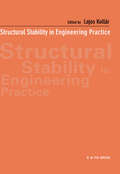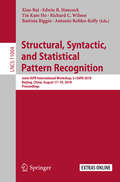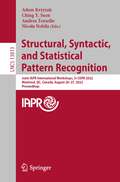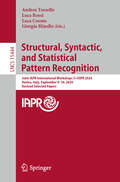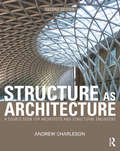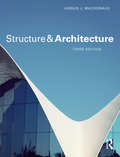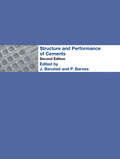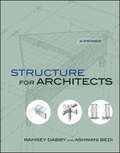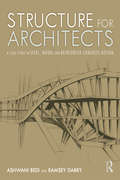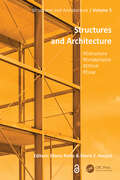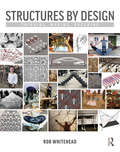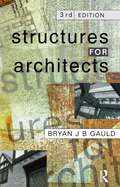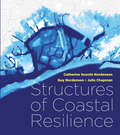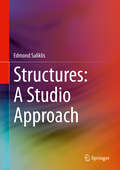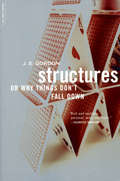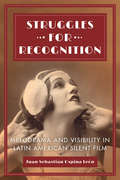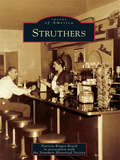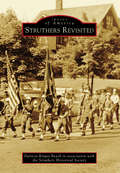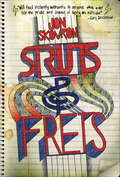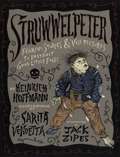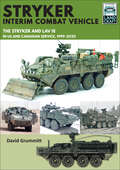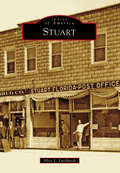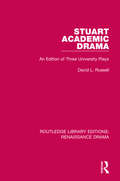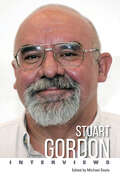- Table View
- List View
Structural Stability in Engineering Practice
by Lajos KollarStructural Stability in Engineering Practice elucidates the various problems associated with attaining stability, and provides the results for practical use by the design engineer. By presenting a simple and visual description of the physical phenomena, the authors show how to determine the critical loads of various structures, such as frames, arch
Structural, Syntactic, and Statistical Pattern Recognition: Joint IAPR International Workshop, S+SSPR 2018, Beijing, China, August 17–19, 2018, Proceedings (Lecture Notes in Computer Science #11004)
by Antonio Robles-Kelly Richard C. Wilson Xiao Bai Battista Biggio Edwin R. Hancock Tin Kam HoThis book constitutes the proceedings of the Joint IAPR International Workshop on Structural, Syntactic, and Statistical Pattern Recognition, S+SSPR 2018, held in Beijing, China, in August 2018.The 49 papers presented in this volume were carefully reviewed and selected from 75 submissions. They were organized in topical sections named: classification and clustering; deep learning and neurla networks; dissimilarity representations and Gaussian processes; semi and fully supervised learning methods; spatio-temporal pattern recognition and shape analysis; structural matching; multimedia analysis and understanding; and graph-theoretic methods.
Structural, Syntactic, and Statistical Pattern Recognition: Joint IAPR International Workshops, S+SSPR 2022, Montreal, QC, Canada, August 26–27, 2022, Proceedings (Lecture Notes in Computer Science #13813)
by Ching Y. Suen Adam Krzyzak Andrea Torsello Nicola NobileThis book constitutes the proceedings of the Joint IAPR International Workshop on Structural, Syntactic, and Statistical Pattern Recognition, S+SSPR 2022, held in Montreal, QC, Canada, in August 2022.The 30 papers together with 2 invited talks presented in this volume were carefully reviewed and selected from 50 submissions. The workshops presents papers on topics such as deep learning, processing, computer vision, machine learning and pattern recognition and much more.
Structural, Syntactic, and Statistical Pattern Recognition: Joint IAPR International Workshops, S+SSPR 2024, Venice, Italy, September 9–10, 2024, Revised Selected Papers (Lecture Notes in Computer Science #15444)
by Luca Rossi Andrea Torsello Luca Cosmo Giorgia MinelloThis book constitutes the proceedings of the Joint IAPR International Workshops on Structural, Syntactic, and Statistical Pattern Recognition, S+SSPR 2024, which took place in Venice, Italy, during September 9-11, 2024. The 19 full papers presented in this volume were carefully reviewed and selected from 27 submissions. The proceedings focus on pattern recognition, including classification and clustering, deep learning, structural matching and graph-theoretic methods, and multimedia analysis and understanding.
Structure As Architecture: A Source Book for Architects and Structural Engineers
by Andrew CharlesonStructure as Architecture presents a comprehensive analysis of the indispensable role of structure in architecture. An exploration, as well as a celebration, of structure, the book draws on a series of design studies and case study examples to illustrate how structure can be employed to realize a wide range of concepts in contemporary architecture. By examining design principles that relate to both architecture and structural engineering, Andrew Charleson provides new insights into the relationship between both the technical and aesthetic aspects of architecture. Now in its second edition, the text has been extensively revised and updated throughout. Features include: A brand new chapter on hidden structure, adding to the material on exposed structures Two new chapters on using structure to realise common architectural concepts through a combination of precedents and creative design Over 50 new case studies from across the globe Easy-to-understand diagrams and a highly visual design to aid understanding and accessibility More than two hundred case studies of contemporary buildings from countries such as the UK, the US, France, Germany, Spain, Hong Kong, Australia and Japan illustrate how a thorough integration of structure adds layers of richness and enhances the realisation of architectural design concepts.
Structure and Architecture
by Angus J. MacdonaldThis thoroughly updated edition of Angus J. Macdonald’s insightful book Structure and Architecture offers an in depth analysis of structural design and its relationship with architecture. It draws on clear explanations of the connections between structural form, structural performance and architectural design to explore the interface between the technical and the visual in architecture. Additional chapters in this new edition cover the fields of structural theory, structural philosophy, the contributions of prominent engineers to the evolution of Modern architecture, and the concept and practice of sustainable design. Fully illustrated, this critical appraisal of structures is a core-curriculum text for students of architecture, structural engineering and architectural history, and is also a valuable resource for practitioners of these disciplines.
Structure and Performance of Cements
by P. Barnes J. BenstedDrawing together a multinational team of authors, this second edition of Structure and Performance of Cements highlights the latest global advances in the field of cement technology. Three broad categories are covered: basic materials and methods, cement extenders, and techniques of examination. Within these categories consideration has been given
Structure for Architects
by Ramsey Dabby Ashwani BediAn introduction to the concepts and principles of architectural structures in an easy-to-read format Written as an easy-to-understand primer on the topic, Structure for Architects engages readers through instruction that uses a highly visual format and real-world examples to underline the key facets of structural principles that are essential to the design process. Eschewing complicated mathematics and technical jargon, Structure for Architects demystifies the subject matter by showing it in the context of everyday situations, giving architects and architectural technologists a clear understanding of how to incorporate structural principles into their designs. Highlights of this book include: A rich collection of drawings, photographs, and diagrams, spread throughout the text, which demonstrate fundamental structural concepts using everyday examples An overview of structural design basics, as well as a summary of structural forms A look at the design implications of steel, reinforced concrete, and wood By providing an overall view of structures that covers the essentials of what architects and architectural technologists need to know, Structure for Architects is a valuable tool for illustrating the importance of designing with structure in mind and for learning the basics that are necessary for collaborating confidently with project team members.
Structure for Architects: A Case Study in Steel, Wood, and Reinforced Concrete Design
by Ramsey Dabby Ashwani BediStructure for Architects: A Case Study in Steel, Wood, and Reinforced Concrete Design is a sequel to the authors’ first text, Structure for Architects: A Primer, emphasizing the conceptual understanding of structural design in simple language and terms. This book focuses on structural principles applied to the design of typical structural members—a beam, a girder, and a column—in a diagrammatic frame building. Through the application of a single Case Study across three key materials, the book illustrates the theory, principles, and process of structural design. The Case Study progresses step-by-step for each material, from determining tributary areas and loads through a member's selection and design. The book addresses the frequent disparity between the way architects and engineers perceive and process information, with engineers focusing on technical aspects and architects focusing on visual concepts. Structure for Architects: A Case Study in Steel, Wood, and Reinforced Concrete Design presents readers with an understanding of fundamental engineering principles through a uniquely thematic Case Study. Focusing on the conceptual understanding of structural design, this book will be of interest to architecture students and professionals looking to understand the application of structural principles in relation to steel, wood, and concrete design.
Structures and Architecture: REstructure REmaterialize REthink REuse (Structures & Infrastructures Series)
by Mario RinkeStructures and Architecture - REstructure REmaterialize REthink REuse contains the contributions to the 6th International Conference on Structures and Architecture (ICSA 2025, Antwerp, Belgium, 8-11 July 2025). As a response to the pressing global climate and energy crisis, and with new settings and tools, the design and construction of our built environment needs reconsideration and extension. The papers call for a re-imagination of current practices regarding structures and architecture.The volumes of the series are published every three years, in tandem with the conferences organised by the International Association of Structures and Architecture. They aim to reach a global audience of researchers, practitioners, and students, including architects, structural and construction engineers, builders and building consultants, constructors, material suppliers, planners, urban designers, anthropologists, economists, sociologists, artists, product manufacturers, and other professionals involved in the design and realisation of architectural, structural, and infrastructural projects.
Structures by Design: Thinking, Making, Breaking
by Rob WhiteheadStructures by Design: Thinking, Making, Breaking is a new type of structures textbook for architects who prefer to learn using the hands-on, creative problem-solving techniques typically found in a design studio. Instead of presenting structures as abstract concepts defined by formulas and diagrams, this book uses a project-based approach to demonstrate how a range of efficient, effective, and expressive architectural solutions can be generated, tested, and revised. Each section of the book is focused on a particular manner by which structural resistance is provided: Form (Arches and Cables), Sections (Beams, Slabs, and Columns), Vectors (Trusses and Space Frames), Surfaces (Shells and Plates), and Frames (Connections and High-Rises). The design exercises featured in each chapter use the Think, Make, Break method of reiterative design to develop and evaluate different structural options. A variety of structural design tools will be used, including the human body, physical models, historical precedents, static diagrams, traditional formulae, and advanced digital analysis. The book can be incorporated into various course curricula and studio exercises because of the flexibility of the format and range of expertise required for these explorations. More than 500 original illustrations and photos provide example solutions and inspiration for further design exploration.
Structures for Architects
by Bryan J.B. GauldDemand from building control officials for structural calculations - even for very simple projects - means that today's architects must have a thorough understanding of everyday structural concepts.Structures for Architects satisfies the need for a basic introduction to the structural problems encountered by the architect, surveyor and builder. This third edition reflects advances in recent techniques and refers to current Building Regulations and Codes of Practice.Students of architecture, building and surveying at degree, diploma or professional (RIBA, RICS, CIOB) examination level will find this book a valuable course text. Professionals in these fields who must perform structural calculations to satisfy building control authorities will also find it a useful handbook.
Structures of Coastal Resilience
by Julia Chapman Catherine Seavitt Nordenson Guy NordensonStructures of Coastal Resilience presents new strategies for creative and collaborative approaches to coastal planning for climate change. In the face of sea level rise and an increased risk of flooding from storm surge, we must become less dependent on traditional approaches to flood control that have relied on levees, sea walls, and other forms of hard infrastructure. But what are alternative approaches for designers and planners facing the significant challenge of strengthening their communities to adapt to uncertain climate futures?Authors Catherine Seavitt Nordenson, Guy Nordenson, and Julia Chapman have been at the forefront of research on new approaches to effective coastal resilience planning for over a decade. In Structures of Coastal Resilience, they reimagine how coastal planning might better serve communities grappling with a future of uncertain environmental change. They encourage more creative design techniques at the beginning of the planning process, and offer examples of innovative work incorporating flexible natural systems into traditional infrastructure. They also draw lessons for coastal planning from approaches more commonly applied to fire and seismic engineering. This is essential, they argue, because storms, sea level rise, and other conditions of coastal change will incorporate higher degrees of uncertainty—which have traditionally been part of planning for wildfires and earthquakes, but not floods or storms.This book is for anyone grappling with the immense questions of how to prepare communities to flourish despite unprecedented climate impacts. It offers insights into new approaches to design, engineering, and planning, envisioning adaptive and resilient futures for coastal areas.
Structures of Feeling in Seventeenth-Century Cultural Expression
by Susan McclaryBetween the waning of the Renaissance and the beginning of the Enlightenment, many fundamental aspects of human behaviour - from expressions of gender to the experience of time - underwent radical changes. While some of these transformations were recorded in words, others have survived in non-verbal cultural media, notably the visual arts, poetry, theatre, music, and dance. Structures of Feeling in Seventeenth-Century Cultural Expression explores how artists made use of these various cultural forms to grapple with human values in the increasingly heterodox world of the 1600s.Essays from prominent historians, musicologists, and art critics examine methods of non-verbal cultural expression through the broad themes of time, motion, the body, and global relations. Together, they show that seventeenth-century cultural expression was more than just an embryonic stage within Western artistic development. Instead, the contributors argue that this period marks some of the most profound changes in European subjectivities.
Structures: A Studio Approach
by Edmond SaliklisUnderstanding how gravity loads and wind and earthquake loads flow through a building is of utmost importance to all structural engineers and architects. Paradoxically, this critical idea is practically not addressed in any textbook on the market. Meant as a companion to the author’s Structures: A Geometric Approach, this textbook fills that need with qualitative techniques as well as quantitative tools that use state of the art visual representation of forces and deformations in structures. Structures: A Studio Approach reaches out to both structural engineers and designers by presenting structural engineering topics in an interdisciplinary studio environment. Using many graphical techniques, it offers a very rigorous approach, but also enables creativity. Cutting edge finite element as well as parametric modeling tools are used, and state of the art visual representations of force flow help both groups of students realize that understanding three dimensional load flow in a building is a requirement for channeling that flow in a structurally efficient and visually expressive manner. Ultimately, the reader is able to develop a unique structural sensibility; an ethos that places structural design on an equal footing with the design of program, skin, massing and site.
Structures: Or Why Things Don't Fall Down (Penguin Science Ser.)
by J. E. GordonFor anyone who has ever wondered why suspension bridges don't collapse under eight lanes of traffic, how dams hold back-or give way under-thousands of gallons of water, or what principles guide the design of a skyscraper or a kangaroo, this book will ease your anxiety and answer your questions. J. E. Gordon strips engineering of its confusing technical terms, communicating its founding principles in accessible, witty prose.
Struggles for Recognition: Melodrama and Visibility in Latin American Silent Film
by Juan Sebastián Ospina LeónStruggles for Recognition traces the emergence of melodrama in Latin American silent film and silent film culture. Juan Sebastián Ospina León draws on extensive archival research to reveal how melodrama visualized and shaped the social arena of urban modernity in early twentieth-century Latin America. Analyzing sociocultural contexts through film, this book demonstrates the ways in which melodrama was mobilized for both liberal and illiberal ends, revealing or concealing social inequities from Buenos Aires to Bogotá to Los Angeles. Ospina León critically engages Euro-American and Latin American scholarship seldom put into dialogue, offering an innovative theorization of melodrama relevant to scholars working within and across different national contexts.
Struthers
by Patricia Ringos Beach Struthers Historical SocietyStruthers is the story of a small town in northeastern Ohio. The town began with the stumbling start of John Struthers as he chased a band of marauding Native Americans through the valley. He later came to settle in what would eventually be Yellow Creek Park. He lost a son and most of his fortune after the War of 1812. Later another son, Thomas, would return as a wealthy entrepreneur to reclaim the family land in his father's memory and help develop the town. The steel industry played a large role in shaping Struthers, as have Yellow Creek Park and Lake Hamilton by offering its hardworking residents places of beauty to relax and enjoy. The historic images in this book capture moments in everyday life in Struthers, from its incorporation to present day. This book is for longtime residents, newcomers, and passersby alike so they may treasure and remember Struthers's history for years to come.
Struthers Revisited (Images of America)
by Patricia Ringos Beach Struthers Historical SocietyWhat more is there to say about Struthers that was not said in Images of America: Struthers, published in 2008? It turns out there is plenty. Images of America: Struthers Revisited features the people and places that filled this northeastern Ohio town in the 1900s. Through the growth and decline of the steel industry, the town prospered and adapted. Children grew up, marriages occurred, and people died; however, as anyone affiliated with Struthers knows, they could not be buried in the "city without a cemetery." This collection of images illustrates stories of accomplishment, struggle, and everyday life. Photographs of schools, churches, small grocery stores, businesses, eateries, parks, and playgrounds will transport readers to a time that is both familiar and historical. This walk down memory lane is for all ages. It is for those who reside in Struthers and those who used to live there and love to visit.
Struts & Frets
by Jon SkovronMusic is in Sammy’s blood. His grandfather was a jazz musician, and Sammy’s indie rock band could be huge one day—if they don’t self-destruct first. Winning the upcoming Battle of the Bands would justify all the band’s compromises and reassure Sammy that his life’s dream could become a reality. But practices are hard to schedule when Sammy’s grandfather is sick and getting worse, his mother is too busy to help either of them, and his best friend may want to be his girlfriend. When everything in Sammy’s life seems to be headed for major catastrophe, will his music be enough to keep him together?
Struwwelpeter
by Heinrich HoffmannThis sadistic classic includes Sarita Vendetta's macabre illustrations to Heinrich Hoffmann's verse, and the entire original edition in color.
Stryker Interim Combat Vehicle: The Stryker and LAV III in US and Canadian Service, 1999–2020 (LandCraft)
by David GrummittThis illustrated modeling guide reviews the full range of kits and accessories available to model the Stryker and LAV III in all the major scales.The Stryker interim combat vehicle was a stop-gap measure, designed to help the United States project its military force in hotspots around the world. First deployed in Iraq in 2003, it has since proved itself an integral part of the US’s warfighting capability. Today the Stryker has been adapted to face the new threat of a resurgent Russia.This volume in the LandCraft series of modeling guides examines the Stryker and LAV III in US, Canadian and New Zealand service. In addition to describing the design, development, and operational history of the Stryker and LAV III, David Grummitt gives a full account of available modeling kits and accessories. Six builds are featured, covering the most important variants. Detailed color profiles provide both reference and inspiration for modelers and military enthusiasts alike.
Stuart (Images of America)
by Alice L. LuckhardtOn the southeast coast of Florida in the 1880s, a quaint little community was nestled along the tranquil waters of the St. Lucie River in a wilderness of tropical beauty, one of the region's last frontiers. As lucrative pineapple crops and the commercial fishing industry began to flourish, trade boats brought necessary supplies, and new settlers arrived on river steamers. With land available for homesteading or for sale at $1.25 an acre, the small village soon to be known as Stuart would become a mecca for innovative, hardworking young men seeking business and financial opportunities. By the dawn of the 20th century, the railroad had been established, and the town, forged by the fortitude of early pioneers, thrived, eventually becoming a beautiful, friendly incorporated city.
Stuart Academic Drama: An Edition of Three University Plays (Routledge Library Editions: Renaissance Drama)
by David L. RussellAlthough not much is known about the three Stuart plays in this edition, which was first published in 1987, we can ascribe them to one of the English universities, and each is indicative of a distinctly different influence on the Renaissance academic drama. Heteroclitanomalonomia is part of a minor subgenre referred to as the academic play. It demonstrates the predominance of language or rhetoric studies in the period and its very subject is of purely academic interest. Gigantomachia displays the continuing interest of the Renaissance in classical mythology. And A Christmas Messe follows a more homely tradition, a farcical personification of the mundane. This title will be of interest to students of English Literature, Drama and Performance.
Stuart Gordon: Interviews (Conversations with Filmmakers Series)
by Michael DoyleAnimated by a singularly subversive spirit, the fiendishly intelligent works of Stuart Gordon (1947–2020) are distinguished by their arrant boldness and scab-picking wit. Provocative gems such as Re-Animator, From Beyond, Dolls, The Pit and the Pendulum, and Dagon consolidated his fearsome reputation as one of the masters of the contemporary horror film, bringing an unfamiliar archness, political complexity, and critical respect to a genre so often bereft of these virtues. A versatile filmmaker, one who resolutely refused to mellow with age, Gordon proved equally adept at crafting pointed science fiction (Robot Jox, Fortress, Space Truckers), sweet-tempered fantasy (The Wonderful Ice Cream Suit), and nihilistic thrillers (King of the Ants, Edmond, Stuck), customarily scrubbing the sharply drawn lines between exploitation and arthouse cinema.The first collection of interviews ever to be published on the director, Stuart Gordon: Interviews contains thirty-six articles spanning a period of fifty years. Bountiful in anecdote and information, these candid conversations chronicle the trajectory of a fascinating career—one that courted controversy from its very beginning. Among the topics Gordon discusses are his youth and early influences, his founding of Chicago’s legendary Organic Theatre (where he collaborated with such luminaries as Ray Bradbury, Kurt Vonnegut, and David Mamet), and his transition into filmmaking where he created a body of work that injected fresh blood into several ailing staples of American cinema. He also reveals details of his working methods, his steadfast relationships with frequent collaborators, his great love for the works of Lovecraft and Poe, and how horror stories can masquerade as sociopolitical commentaries.
